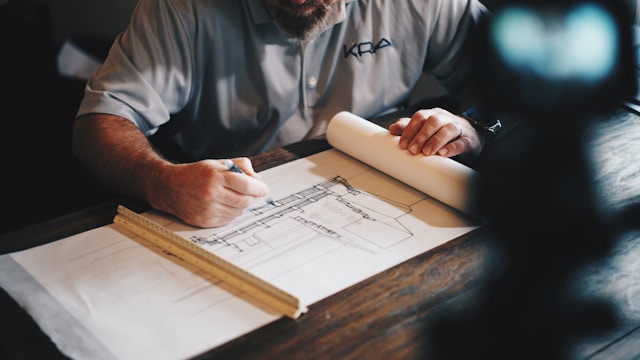Starting a new construction or renovation project is exciting but it can also feel overwhelming if you’re unsure what happens between the first sketch and the final build. Understanding the architectural design process helps you make informed decisions, stay on budget, and collaborate effectively with your architect.
At Lilly Architects, we guide our Tulsa clients through a proven, transparent process that blends creativity with technical precision. Here’s a step-by-step breakdown of what you can expect from the first meeting to project completion.
Step 1: Initial Consultation and Project Discovery
Every successful design begins with a conversation. The initial consultation allows the architect to understand your vision, lifestyle, needs, and constraints.
During this phase, you’ll discuss:
- Your goals and expectations for the project
- Your site location, budget, and timeline
- Design inspiration and preferred architectural style
- Functional needs, sustainability goals, or specific challenges
At Lilly Architects, this is where we start building a relationship of trust and clarity listening carefully before proposing any design direction.
Step 2: Site Analysis and Research
Before designing, architects must understand the site conditions. A detailed site analysis ensures that your project responds intelligently to its environment.
Key evaluations include:
- Site measurements and topography
- Sunlight, wind, and drainage patterns
- Local zoning laws and building codes
- Accessibility, utilities, and surrounding context
In Tulsa, for example, regional factors like weather, soil type, and local ordinances can significantly influence building orientation and materials.
Step 3: Schematic Design
Once the groundwork is set, the architect develops preliminary design ideas that explore form, layout, and function. You’ll typically receive:
- Schematic sketches or 3D renderings
- Site plans and basic floor layouts
- Early discussions about materials and style
This stage focuses on big-picture ideas how spaces feel, connect, and flow. The goal is to refine the design concept that best captures your vision while meeting practical needs.
Tip: Be open to discussion and feedback schematic design is a creative collaboration, not just a presentation.
Step 4: Design Development
After you approve a schematic design, your architect begins detailing the design. In this phase, the abstract ideas turn into detailed plans.
Expect to see:
- Finalized floor plans and elevations
- Structural and mechanical layouts
- Refined material selections and finishes
- Energy efficiency and lighting considerations
At Lilly Architects, we use advanced 3D visualization tools to help clients “walk through” their future space. This ensures alignment between design intent and expectations before construction begins.
Step 5: Construction Documentation
Once the design is finalized, the architect prepares a full set of construction drawings the technical drawings that contractors use to build your project.
These documents include:
- Detailed plans, sections, and elevations
- Specifications for materials and finishes
- Mechanical, electrical, and plumbing details
- Code compliance and permitting documents
This stage is about precision. A well-drafted set of construction documents reduces errors, streamlines approvals, and ensures clear communication with builders and engineers.
Step 6: Permitting and Bidding
Before construction starts, your architect helps you navigate local regulations and obtain necessary permits.
In many Tulsa-area projects, this involves:
- Submitting drawings to city or county building departments
- Addressing review comments or revisions
- Coordination of the process to facilitate the bidding process.
If you’re selecting a contractor, your architect can also assist in the bidding process preparing bid documents, evaluating proposals, and helping you choose the right construction partner.
Step 7: Construction Administration
This is where your design comes to life. Throughout construction, your architect’s role shifts to oversight and quality assurance.
During this phase, expect your architect to:
- Visit the site regularly to review progress
- Ensure construction follows the approved design
- Address field changes or unforeseen issues
- Review shop drawings and material samples
At Lilly Architects, our involvement doesn’t end with drawings we stay engaged from the first brick to the final finish to ensure your project is executed as envisioned.
Step 8: Project Completion and Handover
Once construction wraps up, the architect conducts a final walkthrough to ensure everything aligns with design specifications. This phase includes:
- Punch-list creation (minor corrections or touch ups)
- Verification of systems and finishes
- Final approval before move-in
You’ll receive as-built drawings, warranties, and documentation for future reference. This closes the project but marks the beginning of your experience with the finished space.
Step 9: Post-Occupancy Evaluation (Optional but Valuable)
Some architects offer post-occupancy evaluations several months after completion to review how the building performs in real use. This step helps both architect and client learn from experience improving comfort, functionality, and long term efficiency.
At Lilly Architects, we believe every project is a partnership that extends beyond completion. Your feedback informs how we design better spaces for Tulsa’s evolving communities.
Final Thoughts
The architectural design process is a structured, collaborative journey. Each step discovery, design, documentation, and construction plays a critical role in bringing your ideas to life.
By understanding what to expect at every stage, you can make confident decisions, stay aligned with your architect, and enjoy the creative process.
If you’re planning a residential, commercial, or historic renovation project in Oklahoma, Lilly Architects is here to guide you through every step with clarity, creativity, and craftsmanship.
Contact us: connect@lillyarch.com

